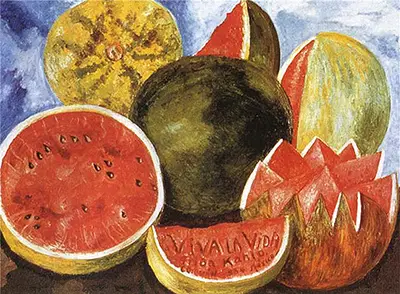The painting is full of vibrant colours and depicts watermelons in still life in various cut shapes including whole, sliced in half, sliced in a quarter, and sliced in a flower-like shape. The watermelons each have different shades of green, perhaps symbolising changes in ripeness and therefore growing older or passing through various stages of life.
Despite being in poor health in 1953, Frida was able to complete this painting showing a lively scene with a fruit symbolising the vibrancy of life. During the Dia de los Muertos, watermelons were often used to symbolise connections to the dead or being consumed by the dead. The sharp reds contrast nicely with the softer greens and blues used in the painting. Showing these reds allowed Frida to exude a sense of life from within the watermelons, which itself contrasts with her poor health and subsequent death. This type of dualism is frequent in her works. She also completed many other still life paintings, many of which include melons and other tropical fruits.
Frida's last work includes her signature style of dualism as well as the clear and intentioned use of bright and vibrant colours to delineate the viewer's attention from the flat and darker colours from the main area of focus. Here, it appears to be the red pulp within each watermelon that draws the most attention. Inscribed eight days before her death, the lower watermelon says within its red pulp: "VIVA LA VIDA – Coyoacán 1954 Mexico," which denotes in English "Long live life" followed by her place of birth and death as well as the date of the painting.
Her death was unfortunately quite painful. She noted in her diary just days before her death that "the exit is joyful, and I hope never to return." Her passage from life towards her death can be encapsulated in the dualistic style employed in this very painting. This work was completed in 1954 by medium of oil on masonite. It is currently located at the Frida Kahlo Museum in Mexico City.

